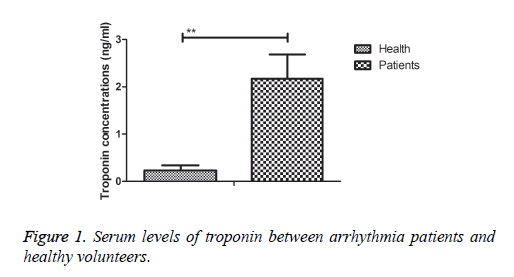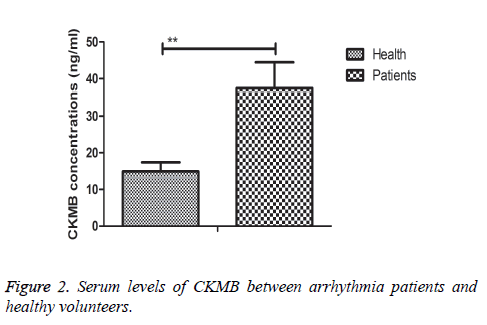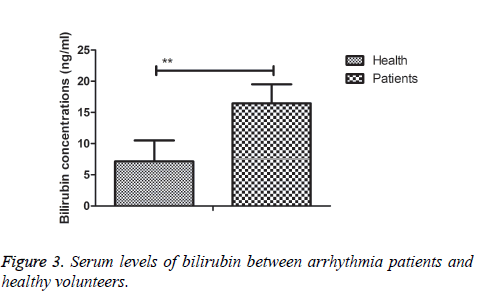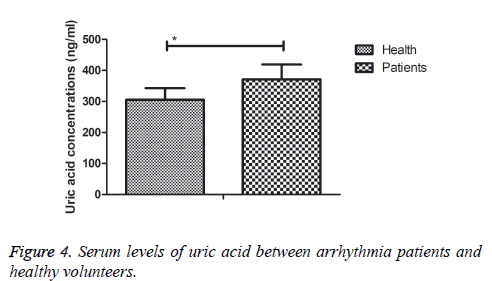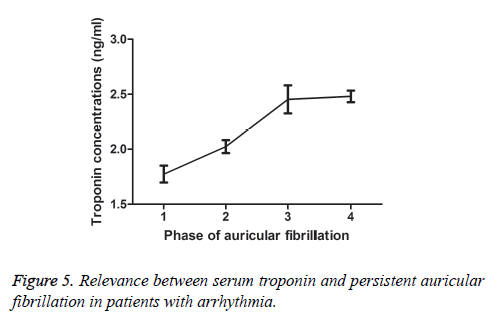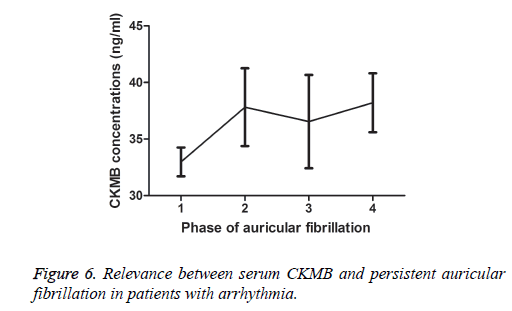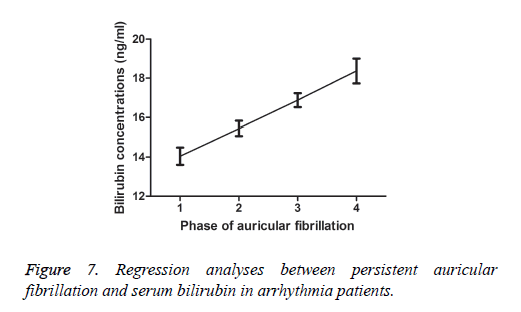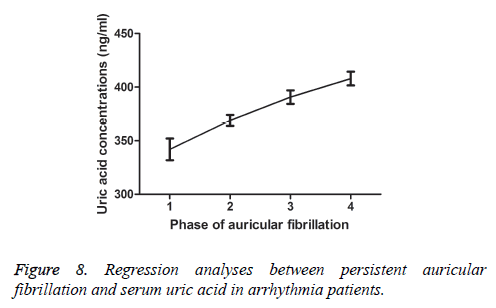Research Article - Biomedical Research (2017) Volume 28, Issue 9
Regression analysis between persistent auricular fibrillation and serum bilirubin and uric acid in patients with arrhythmia
Xiu-rong Gao1, Zong-shan Ji1, Jing-ying Su1, Wei-wei Miao1 and Chun-mei Wang2*1Department of the Third Cadre’s ward, the First Hospital of Harbin, City, Harbin, China
2Emergency and Critical Care Center, Beijing Anzhen Hospital, Capital Medical University, Beijing Institute of Heart Lung and Blood Vessel Disease, Beijing, China
- *Corresponding Author:
- Chun-mei Wang
Emergency and Critical Care Center
Beijing Anzhen Hospital
Capital Medical University Beijing Institute of Heart Lung and Blood Vessel Disease
China
Accepted date: February 06, 2017
Abstract
Persistent atrial fibrillation is one of the most common arrhythmias, which is caused by disorderly excited and invalid contract room sex rhythm in patients with arrhythmia. Evidences have indicated that plasma concentration levels of bilirubin and serum uric acid are associated with progression of auricular fibrillation. In this clinical investigation, regression analysis between auricular fibrillation and plasma concentration of bilirubin and serum uric acid was analysed in patients with arrhythmia. A total of 1348 arrhythmia patients and 346 healthy volunteers were voluntarily recruited in this analysis. Cumulative incidence probability of persistent atrial fibrillation and paroxysmal atrial fibrillation were analysed. Outcomes demonstrated that plasma concentration levels of troponin, CKMB, bilirubin and serum uric acid were up-regulated in patients with arrhythmia. Our results auricular fibrillation in Left Atrium (LA) and Left Ventricle (LV) in arrhythmia patients were significantly difference with healthy volunteers. Notably, we observed that a plasma concentration level of bilirubin is positively correlated with degree of auricular fibrillation in patients with arrhythmia determined by univariate analysis. Serum uric acid is also positively correlated with degree of auricular fibrillation in patients with arrhythmia determined by univariate analysis. In conclusion, these outcomes indicate that persistent auricular fibrillation and plasma concentration levels of bilirubin and serum uric acid is up-regulated and positively correlated clinical stages in patients with arrhythmia, which may be regarded as indicator and prognostic factors for arrhythmia in clinical.
Keywords
Auricular fibrillation, Arrhythmia, Bilirubin, Uric acid, Arrhythmia, Regression analysis
Introduction
Arrhythmia is divided into rapidity and tardy arrhythmia according to the clinical onset of arrhythmia heart rate speed [1]. Clinical taxonomy has been identified five types, including extrasystole, atrial flutter and atrial fibrillation, supraventricular tachycardia, ventricular tachycardia and ventricular fibrillation and bradycardia [2]. A systematic review and meta-analysis has showed that pathogenetic mechanism of arrhythmia is induced by abnormal of the heart's frequency and rhythms, impulse, conduction velocity and the origin of the excited order [3,4]. Clinical reports also revealed that arrhythmia can lead to myocardial dysfunction and even myocardial infarction, heart failure [5-7].
Atrial fibrillation is the most common symptoms in the initiation and development of arrhythmia [8]. Atrial flutter or fibrillation is the most frequent and life-threatening arrhythmia in myotonic dystrophy, which is reported in myotonic dystrophy caused by several arrhythmias [9]. Systematic review and meta-analysis have revealed that atrial fibrillation increased ischemic stroke risk in for clinical patients determined by CHA2DS2-VASc Score [10,11]. In addition, Miyazaki et al. have suggested that impact of atrial fibrillation termination site and termination mode can regarded as a predictor of clinical outcome after persistent in catheter ablation on arrhythmia recurrence [12]. Furthermore, detection and treatment of subclinical atrial fibrillation presents clinical value in evaluating the IMPACT of a comprehensive strategy based on remote arrhythmia monitoring [13]. These reports indicate that atrial fibrillation acts as essential role in the progression of arrhythmia.
Serum bilirubin and uric acid is associated with pathological factors in the progression of cardiovascular diseases [14,15]. Research has showed that serum bilirubin can be regarded as a prognostic marker in patients with acute decompensated heart failure [16]. Reports also indicated that serum uric acid is associated with mortality and heart failure hospitalizations in patients with complicated myocardial infarction [17]. In this study, we investigated serum levels of bilirubin and uric acid in patients with arrhythmia, who have presented atrial fibrillation in clinical. We also performed regression analysis between persistent auricular fibrillation and serum bilirubin and uric acid in patients with arrhythmia. Our findings provide evidences that serum bilirubin and uric acid may be regarded as indicator and prognostic factors for patients with arrhythmia in clinical.
Materials and Methods
Patients and healthy volunteers
A total of 1348 patients with arrhythmia and 346 healthy volunteers were recruited to analysis the association of serum bilirubin and uric acid with persistent auricular fibrillation. The numbers of men and women patients were approximate equal. All participants were eligible to finish this clinical investigation.
ELISA
Serum levels of troponin (NO: MAB8595), CKMB (NO: MAF10238), bilirubin (NO: AF3776) and uric acid (NO: RM3846) were detected in patients with arrhythmia using ELISA kit (Bio-Techne, R&D Systems, USA) according to the manufacturer’s instrument. Finally, the serum concentration levels of troponin, CKMB, bilirubin and uric acid were measured by an enzyme micro-plate reader at 450 nm.
Detection of physiological indexes in patients with arrhythmia and healthy volunteers
Physiological indexes of Heart Volume (HV), Left Ventricular Ejection Fraction (LVEF), Pulmonary Capillary Wedge Pressure (PCWP), Cardiac Index (CI), Cardiac Output (CO), Stroke Volume (SV), Left Ventricular Posterior Wall (LVPW), Interventricular Septal Thickness (IVS), Left Atrium (LA) and Left Ventricle (LV) were analysed according to previous reports [18].
Regression analysis
The serum levels of bilirubin and uric acid in the detective data (Y) by regression analysis in different clinical stage persistent auricular fibrillation patients with arrhythmia using least square convergence [19]. The predicted curve that results in the lowest sum of squares is the best fit. If the fit is robust, then the parameters of the observed curve can be inferred from those of the predicted.
Statistical analysis
For each experiment, the mean and standard error were determined. Statistical differences between groups were assessed by means of Analysis of Variance (ANOVA) from 6 replicate experiments with the post-hoc Dunnett’s test. Statistical significance was considered at P<0.05.
Results
Characteristics of patients with arrhythmia
A total of 1348 patients with arrhythmia were recruited to identify the correlation of serum bilirubin and uric acid with atrial fibrillation. 346 healthy volunteers were voluntarily recruited as control in this analysis. The characteristics of patients with arrhythmia were summarized in Table 1. The numbers of man and women patients was approximately equal. The median age of patients was 35.1 ± 17.5 years old.
| Characteristics | Patients | Health |
|---|---|---|
| Number | 1348 | 346 |
| Female | 684 | 170 |
| Male | 664 | 176 |
| Age | 15.2-62.8 | 21.2-56.4 |
| Clinical stage | ||
| 1 | 395 | 0 |
| 2 | 310 | 0 |
| 3 | 332 | 0 |
| 4 | 311 | 0 |
| Blood pressure | 114.6 ± 15.4 | 118.8 ± 9.2 |
| Blood glucose | 7.5 ± 2.2 | 7.4 ± 2.6 |
Table 1: Characteristic of patients with arrhythmia.
Analysis of changes of physiological indexes in patients with arrhythmia
Physiological indexes were analysed in arrhythmia patients with healthy volunteers as control. Outcomes analysed the statistical difference of Heart Volume (HV), Left Ventricular Ejection Fraction (LVEF), Pulmonary Capillary Wedge Pressure (PCWP), Cardiac Index (CI), Cardiac Output (CO), Stroke Volume (SV), LVPW, IVS, LA and LV between patients and healthy volunteers (Table 2). Outcomes showed that SV, CI, LVEF, and CO were lower in arrhythmia patients compared to healthy volunteers (P<0.05). LA, LV and IVS presented no significant difference between arrhythmia patients and healthy volunteers (P>0.05). Clinical investigation also indicated that HV, LVPW and PCWP were higher in arrhythmia patients compared to healthy volunteers (P<0.05). These outcomes suggest that changes of partial physiological indexes were significance in arrhythmia patients with arrhythmia compared to healthy volunteers.
| Characteristics | Patients | Health |
|---|---|---|
| HV (cm3) | 14.2 × 12.2 × 7.4* | 13.2 × 10.4 × 6.5 |
| LVEF | 45 ± 15 | 56 ± 8* |
| PCWP (kpa) | 2.6 ± 0.7* | 1.4 ± 0.6 |
| CI (L/min/m3) | 2.35 ± 0.36 | 3.34 ± 0.22* |
| CO (ml/min) | 3834 ± 468 | 5068 ± 358* |
| SV | 7.24 ± 2.35 | 10.24 ± 1.82* |
| LVPW (cm) | 15.4 ± 4.3* | 9.4 ± 2.3 |
| IVS | 10 ± 3 | 9 ± 2 |
| LA | 39 ± 6 | 37 ± 5 |
| LV | 45 ± 210 | 48 ± 11 |
Table 2: Physiological index in patients with arrhythmia.
Analysis of serum troponin, CKMB, bilirubin and uric acid in patients with arrhythmia
Plasma concentration levels of troponin, CKMB, bilirubin and uric acid were investigated between arrhythmia patients and healthy volunteers. As shown in Figure 1, serum levels of troponin were up-regulated in patients with arrhythmia compared to healthy volunteers. Outcomes showed that CKMB concentration levels were also increased in patients with arrhythmia (Figure 2). We found that serum bilirubin was up-regulated in arrhythmia patients compared to healthy volunteers (Figure 3). Notably, outcomes demonstrated serum levels of uric acid were increased in patients with arrhythmia compared to healthy volunteers (Figure 4). These outcomes suggest that plasma concentration levels of troponin, CKMB, bilirubin and uric acid may be associated with patients with arrhythmia.
Regression analysis between persistent auricular fibrillation and serum bilirubin and uric acid in patients with arrhythmia
Regression analysis between auricular fibrillation and serum bilirubin and uric acid was studied in patients with arrhythmia. Results did not found relevance between serum troponin and CKMB with persistent auricular fibrillation in patients with arrhythmia (Figures 5 and 6). Outcomes demonstrated that serum levels of bilirubin were positively correlated with persistent auricular fibrillation in arrhythmia patients (Figure 7). Investigations in this study showed that plasma concentration levels of uric acid were also positively associated with persistent auricular fibrillation in arrhythmia patients (Figure 8). Collectively, regression analyses suggest that persistent auricular fibrillation is positively correlated with serum bilirubin and uric acid in patients with arrhythmia.
Discussion
Cardiac arrhythmia is one of the most common clinical manifestations in patients with cardiovascular diseases [20]. Persistent auricular fibrillation frequently occurs in patients with cardiac arrhythmia, which is related with cardiac pathological changes, physiological functions and others myocardial diseases [7,21]. Increasing uric acid level is reported to be related to the development of Left Ventricular Hypertrophy (LVH) that is associated with high incidence of Ventricular Tachycardia (VT) and sudden cardiac death in patients with left ventricular hypertrophy [22]. Research also indicated the role of bilirubin, vitamin C and ceruloplasmin in the progression of coronary artery disease [23]. In this study, we investigated the characteristics of patients with cardiac arrhythmia and analysed correlations between persistent auricular fibrillation and serum bilirubin and uric acid in patients with arrhythmia. Findings suggest that plasma concentration levels of troponin, CKMB, bilirubin and uric acid may be associated with patients with arrhythmia and persistent auricular fibrillation is positively correlated with serum bilirubin and uric acid in patients with arrhythmia.
A systematic review has indicated the effectiveness of catheter ablation NavX mapping system for treatment of the cardiac arrhythmia by impartments of persistent auricular fibrillation [24]. Previous study has indicated that the system of haemostasis of the left atrial appendage is considered to be main cause of thromboembolic complications of atrial fibrillation in patients with atrial fibrillation [25]. In addition, stroke prevention is of vital importance in the management of atrial fibrillation and left atrial appendage exclusion for prevention of stroke has been reviewed by regulation of atrial fibrillation [26]. Furthermore, Lopes et al. have assessed bleeding risk in patients with atrial fibrillation and indicated that atrial fibrillation may lead to [27]. In this study, our investigations showed that SV, CI, EF, and CO were lower and HV, LVPW, SV I-VEDP and PCWP were higher in arrhythmia patients compared to healthy volunteers. These physiological indexes suggest that atrial fibrillation is associated with patients with arrhythmia in clinical.
Retrospective chart review has indicated the efficacy of troponin utilization in patients presenting with atrial fibrillation [28]. Shand et al. have suggested that serum levels of CKMB and troponin in post coronary artery bypass surgery show a graded association with mortality [29]. The prognostic significance of increased serum bilirubin levels coincident with cardiac decompensation in chronic heart failure and may be regarded as prognostic indicator in chronic heart failure [30]. Substantial bodies of epidemiological and experimental evidences have suggested that the significance of serum uric acid cab be regarded as an important and independent risk factor of cardio vascular and renal diseases especially in patients’ arrhythmia in clinical [31]. In this study, our outcomes indicate that serum levels of troponin and CKMB were up-regulated in patients with arrhythmia in clinical. Notably, outcomes demonstrated serum levels of bilirubin and uric acid were increased in patients with arrhythmia compared to healthy volunteers. Interestingly, regression analyses suggest that persistent auricular fibrillation is positively correlated with serum bilirubin and uric acid in patients with arrhythmia.
In conclusion, complications in patients with arrhythmia require innovative analysis responsible for prevention and treatment of atrial fibrillation. Our present work showed that through a large numbers of reports have analysed changes of serum levels of bilirubin and uric acid in patients with arrhythmia, regression analyses between atrial fibrillation and serum levels of bilirubin and uric acid have not been investigated in arrhythmia patients in clinical. Our study highlights correlation of serum levels of bilirubin and uric acid with atrial fibrillation. Findings indicate that serum levels of bilirubin and uric acid are up-regulated in patients with arrhythmia, which is positively correlated with atrial fibrillation. Importantly, these outcomes serum levels of bilirubin and uric acid may be independent prognostic factors for the progression of arrhythmia in clinical.
References
- Katritsis D. Arrhythmia & electrophysiology review-do we need another journal? Arrhythm Electrophysiol Rev 2012; 1: 6.
- Banning AS, Ng GA. Driving and arrhythmia: a review of scientific basis for international guidelines. Eur Heart J 2013; 34: 236-244.
- Nayyar S, Ganesan AN, Brooks AG, Sullivan T, Roberts-Thomson KC, Sanders P. Venturing into ventricular arrhythmia storm: a systematic review and meta-analysis. Eur Heart J 2013; 34: 560-571.
- Syed FF, Asirvatham SJ, Francis J. Arrhythmia occurrence with takotsubo cardiomyopathy: a literature review. Europace: European pacing, arrhythmias, and cardiac electrophysiology. Working groups on cardiac pacing, arrhythmias cardiac cellular electrophysiology. Eur Soc Cardiol 2011; 13: 780-788.
- Zuchinali P, Ribeiro PA, Pimentel M, da Rosa PR, Zimerman LI, Rohde LE: Effect of caffeine on ventricular arrhythmia: a systematic review and meta-analysis of experimental and clinical studies. Europace: European pacing, arrhythmias, and cardiac electrophysiology. Working groups on cardiac pacing, arrhythmias cardiac cellular electrophysiology. Eur Soc Cardiol 2016; 18: 257-266.
- Olde Nordkamp LR, Postema PG, Knops RE. Implantable cardioverter-defibrillator harm in young patients with inherited arrhythmia syndromes: A systematic review and meta-analysis of inappropriate shocks and complications. Heart Rhythm Official J Heart Rhythm Society 2016; 13: 443-454.
- Chou R, Weimer MB, Dana T. Methadone overdose and cardiac arrhythmia potential: findings from a review of the evidence for an American pain society and college on problems of drug dependence clinical practice guideline. J Pain Off J Am Pain Soc 2014; 15: 338-365.
- Leong DP, Caron F, Hillis C, Duan A, Healey JS. The risk of atrial fibrillation with ibrutinib use: a systematic review and meta-analysis. Blood 2016; 128: 138-140.
- Brembilla-Perrot B, Schwartz J, Huttin O. Atrial flutter or fibrillation is the most frequent and life-threatening arrhythmia in myotonic dystrophy. Pac Clin Electrophysiol PACE 2014; 37: 329-335.
- Joundi RA, Cipriano LE, Sposato LA, Saposnik G. Response to letter regarding article, ischemic stroke risk in patients with atrial fibrillation and CHA2DS2-VASc score of 1: systematic review and meta-analysis. Stroke J Cerebr Circul 2016; 47: e194.
- Tawfik A, Bielecki JM, Krahn M. Systematic review and network meta-analysis of stroke prevention treatments in patients with atrial fibrillation. Clin Pharmacol Adv Appl 2016; 8: 93-107.
- Miyazaki S, Taniguchi H, Kusa S. Impact of atrial fibrillation termination site and termination mode in catheter ablation on arrhythmia recurrence. Circul J Off Japanese Circ Soc 2014; 78: 78-84.
- Healey JS, Lopes RD, Connolly SJ. The detection and treatment of subclinical atrial fibrillation: evaluating the IMPACT of a comprehensive strategy based on remote arrhythmia monitoring. Eur H J 2015; 36: 1640-1642.
- Cicero AF, Rosticci M, Bove M. Serum uric acid change and modification of blood pressure and fasting plasma glucose in an overall healthy population sample: data from the Brisighella heart study. Ann Med 2016; 1-8.
- Erkan A, Ekici B, Ugurlu M, Is G, Seker R. The role of bilirubin and its protective function against coronary heart disease. Herz 2014; 39: 711-715.
- Chintanaboina J, Haner MS, Sethi A. Serum bilirubin as a prognostic marker in patients with acute decompensated heart failure. Korean J Int Med 2013; 28: 300-305.
- von Lueder TG, Girerd N, Atar D. Serum uric acid is associated with mortality and heart failure hospitalizations in patients with complicated myocardial infarction: findings from the high-risk myocardial infarction database initiative. Eur J Heart Fail 2015; 17: 1144-1151.
- Leite MR, Ramos EM, Kalva-Filho CA. Correlation between heart rate variability indexes and aerobic physiological variables in patients with COPD. Respirology 2015; 20: 273-278.
- Hayes AF, Rockwood NJ. Regression-based statistical mediation and moderation analysis in clinical research: Observations, recommendations, and implementation. Behav Res Therap 2016.
- Maiocco G. Review: magnesium prophylaxis after cardiac surgery reduces the risk of arrhythmia and atrial fibrillation. Evid Nursing 2005; 8: 55.
- Huang YC, Huang JC, Chen SC, Chang JM, Chen HC. Lethal cardiac arrhythmia during central venous catheterization in a uremic patient: a case report and review of the literature. Hemodialysis international. International Symposium on Home Hemodialysis 2013; 17: 644-648.
- Yamada S, Suzuki H, Kamioka M, Kamiyama Y, Saitoh S, Takeishi Y. Uric acid increases the incidence of ventricular arrhythmia in patients with left ventricular hypertrophy. Fukushima J Med Sci 2012; 58: 101-106.
- Verma VK, Ramesh V, Tewari S, Gupta RK, Sinha N, Pandey CM. Role of bilirubin, vitamin C and ceruloplasmin as antioxidants in Coronary Artery Disease (CAD). Ind J Clin Biochem IJCB 2005; 20: 68-74.
- Mobinizadeh M, Arabloo J, Hamouzadeh P, Akbari Sari A. A systematic review of the effectiveness of catheter ablation NavX mapping system for treatment of the cardiac arrhythmia. Med J Islamic Republ Iran 2015; 29: 189.
- Zotova IV, Isaeva M, Vanieva OS, Tsimbalova TE, Alekhin MN, Zateishchikov DA. The system of hemostasis in patients with atrial fibrillation: markers of left auricular thrombosis. Kardiologiia 2008; 48: 36-40.
- Moss JD. Left atrial appendage exclusion for prevention of stroke in atrial fibrillation: review of minimally invasive approaches. Curr Cardiol Rep 2014; 16: 448.
- Lopes LC, Spencer FA, Neumann I. Systematic review of observational studies assessing bleeding risk in patients with atrial fibrillation not using anticoagulants. PloS one 2014; 9: e88131.
- Meshkat N, Austin E, Moineddin R. Troponin utilization in patients presenting with atrial fibrillation/flutter to the emergency department: retrospective chart review. Int J Emerg Med 2011; 4: 25.
- Shand JA, Howe A. CKMB and troponin I levels post coronary artery bypass surgery show a graded association with mortality. Biomark Med 2011; 5: 375.
- Shinagawa H, Inomata T, Koitabashi T. Prognostic significance of increased serum bilirubin levels coincident with cardiac decompensation in chronic heart failure. Circ J Off J Japanese Circ Soc 2008; 72: 364-369.
- Purnima S, El-Aal BG. Serum uric acid as prognostic marker of coronary heart disease (CHD). Clinica e investigacion en arteriosclerosis. Publ Oficial de la Sociedad Espanola de Arteriosclerosis 2016; 28: 216-224.
